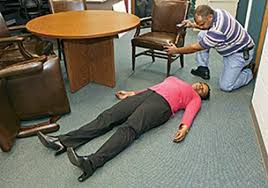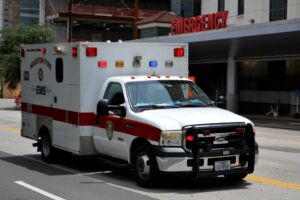Recognizing Signs of an Unconscious Person: First Aid Tips
An unconscious person is someone who is in a state of complete or partial lack of awareness and unable to respond normally to noise, touch, or any other external stimuli. The person appears to be asleep. In this state, the individual is unable to respond to commands and may remain unresponsive even when stimulated. Medical professionals often refer to this condition as altered or decreased level of consciousness. Unconsciousness can be caused by a variety of factors including trauma, dehydration, illness, stroke, head injury, drug overdose or poisoning. Depending on the cause and severity of the condition, a person may regain consciousness after a period of time or remain unconscious for an extended duration that could lead to permanent physical or mental damage. It is therefore important for medical professionals to diagnose and treat an unconscious patient quickly and efficiently. Please keep reading for details on the following topics:
Signs that someone is about to become unconscious
What to do if the person becomes unconscious
Things to do when administering first aid
When to call an ambulance

SIGNS THAT SOMEONE IS ABOUT TO BECOME UNCONSCIOUS
It is important to know when to seek urgent medical care, as delaying appropriate treatment can lead to further health complications. If you experience any of the following symptoms, you should seek medical help immediately. If you have any doubts about whether you should seek medical care, it is always better to err on the side of caution and consult with your doctor. Some common signs include:
-
Verbal Unresponsiveness: Suddenly ceasing to speak or respond verbally to questions or prompts.
- Altered Mental State: Displaying a blank or confused look, indicating a change in mental awareness or clarity.
- Lightheadedness or Dizziness: Feeling faint, dizzy, or unsteady on their feet, often accompanied by difficulty standing.
- Speech Changes: Slurring or mumbling words, which may indicate neurological impairment or altered consciousness.
- Cardiovascular Changes: A slow or rapid heartbeat, which can occur as the body attempts to compensate for decreased blood flow to the brain.
- Respiratory Changes: Difficulty breathing, which may manifest as rapid, shallow breathing or prolonged breath-holding.
- Cyanosis: Bluish discoloration of the skin, particularly around the lips, fingers, or nail beds, indicating poor oxygenation.
-
Loss of Bladder or Bowel Control: Incontinence, or the inability to control urination or defecation, can occur as the body loses consciousness.
CAUSES OF UNCONSCIOUSNESS
Unconsciousness can occur due to various factors, including:
-
Trauma: Falls, serious accidents, or heavy blows to the head or chest can cause unconsciousness by disrupting normal brain function or causing structural damage.
- Medical Conditions: Certain medical conditions can lead to unconsciousness, including stroke, heart attack, seizure disorders, and severe infections.
- Hypoxia: Lack of oxygen to the brain, known as hypoxia, can occur due to conditions such as suffocation, drowning, or severe respiratory failure.
- Hypoglycemia: Low blood sugar levels, often associated with diabetes or excessive insulin administration, can cause unconsciousness if not promptly treated.
- Toxic Exposure: Ingestion or inhalation of toxic substances, including drugs, alcohol, carbon monoxide, or poisonous chemicals, can lead to unconsciousness.
- Dehydration: Severe dehydration, often resulting from fluid loss due to vomiting, diarrhea, or excessive sweating, can lead to electrolyte imbalances and unconsciousness.
- Cardiac Issues: Heart-related conditions such as arrhythmias, heart attack, or sudden cardiac arrest can cause unconsciousness due to inadequate blood flow to the brain.
- Neurological Disorders: Certain neurological conditions, such as epilepsy, brain tumors, or hemorrhages, can lead to unconsciousness when seizures or other complications occur.
- Heat Stroke: Prolonged exposure to high temperatures or strenuous physical activity in hot environments can lead to heat stroke, causing unconsciousness due to overheating of the body.
- Syncope: Fainting, or syncope, can occur due to temporary reductions in blood flow to the brain, often triggered by sudden changes in posture, emotional stress, or dehydration.
-
Hyperventilation: Rapid, shallow breathing, or hyperventilation, can lead to unconsciousness by causing abnormal changes in blood chemistry and oxygen levels.
IF THE PERSON BECOMES UNCONSCIOUS

When dealing with an unconscious person, follow these steps:
- Ensure Safety: Before approaching the person, ensure the environment is safe for both you and the unconscious individual. Check for any potential hazards such as traffic, fire, or electrical hazards.
- Assess Responsiveness: Tap the person’s shoulders gently and ask loudly, “Are you okay?” to assess their level of consciousness. If there is no response, proceed to the next step.
- Call for Help: If the person is unresponsive and not breathing normally, immediately call emergency services or ask someone nearby to call for an ambulance. Time is critical in such situations, and prompt medical assistance is essential.
- Check Breathing and Pulse: If the person is unconscious but breathing normally, place them in a recovery position to maintain an open airway and monitor their breathing until help arrives. If they are not breathing or gasping for air, begin CPR immediately by starting chest compressions.
- Initiate CPR if Necessary: If the person is unconscious and not breathing normally, check for the presence of a pulse. If there is no pulse, begin cardiopulmonary resuscitation (CPR) by providing chest compressions to help circulate blood and oxygen to vital organs until professional medical help arrives.
FIRST AID
First aid is a vital skill for anyone to have as it allows individuals to provide immediate medical care and attention in times of need. Knowing first aid can be the difference between life and death, as it is designed to stabilize serious injuries or illnesses until further medical help arrives on the scene. It is an important part of emergency preparedness and can involve a wide range of techniques, from applying pressure to a wound and controlling bleeding, to administering CPR and using automated external defibrillators (AEDs). First aid also includes basic hygiene practices that are essential for preventing infection and promoting healing. The knowledge of first aid procedures can help you save lives and provide comfort to those in need.
THINGS TO DO WHEN ADMINISTERING FIRST AID
When providing first aid to an unconscious person, it’s crucial to avoid certain actions to prevent further harm:
- Avoid Using a Cushion: Placing a cushion under an unconscious person’s head may exacerbate spinal cord injuries and impede breathing. Maintain a neutral head position to support the airway.
- Do Not Attempt to Sit Them Up: Moving an unconscious person into a sitting position can worsen injuries and compromise their airway. Keep them lying flat unless necessary for CPR.
- Do Not Splash with Water: Splashing water on an unconscious person can startle them without addressing the underlying cause. Focus on assessing their condition and providing appropriate care.
- Avoid Slapping: Slapping an unconscious person is ineffective and potentially harmful. It does not help regain consciousness and may cause injury.
- Do Not Force Liquids: Trying to make an unconscious person drink water or other liquids can lead to aspiration if their protective reflexes are impaired. Focus on maintaining their airway and seeking medical assistance.
- Avoid Removing Obstructions Blindly: Attempting to remove obstructions from the throat without visibility can push them deeper, worsening the situation. Only perform interventions if trained and if the obstruction is visible.
-
Never Leave Unattended: It’s essential to stay with an unconscious person at all times to monitor their condition and provide assistance as needed. Leaving them unattended can delay crucial medical intervention and worsen their outcome.
WHEN TO CALL AN AMBULANCE

Knowing when to call an ambulance is crucial in emergency situations involving an unconscious person. Here are scenarios that warrant calling for immediate medical assistance:
- Before Initiating CPR: If the person is unconscious and not breathing normally, call emergency services before starting CPR. Prompt medical assistance is vital in cardiac arrest situations.
- Loss of Bladder or Bowel Control: Unconsciousness accompanied by loss of bladder or bowel control may indicate a serious medical issue, such as a stroke or seizure, requiring urgent evaluation by medical professionals.
- Seizure or Fit: If the person is experiencing a seizure or fit, especially if it lasts longer than five minutes or is followed by another seizure, call for emergency medical help immediately.
- No Pulse: If you cannot detect a pulse in an unconscious person, it indicates cardiac arrest. Call emergency services immediately and initiate CPR if trained to do so.
- Diabetic: If the unconscious person is known to have diabetes and is exhibiting signs of hypoglycemia (low blood sugar) or hyperglycemia (high blood sugar) that does not improve with treatment, call for medical assistance.
-
Pregnancy: If an unconscious pregnant woman experiences complications such as fainting, sudden loss of consciousness, or any concerning symptoms, it’s essential to call for an ambulance to ensure both her and the baby’s safety.
Disclaimer: The information provided in this content is for general informational purposes only. It is not intended as medical or healthcare advice, diagnosis, or treatment. Always seek the advice of a qualified healthcare professional with any questions you may have regarding a medical condition or healthcare decisions.

